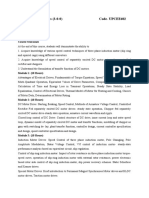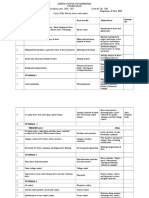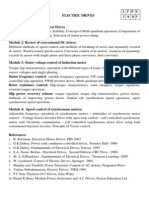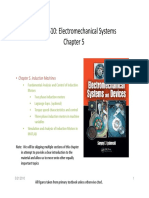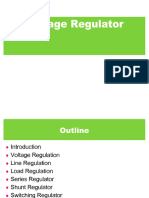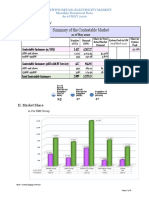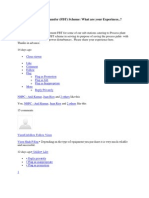Electrical Drive
Electrical Drive
Uploaded by
KUNAL SINGHCopyright:
Available Formats
Electrical Drive
Electrical Drive
Uploaded by
KUNAL SINGHOriginal Description:
Copyright
Available Formats
Share this document
Did you find this document useful?
Is this content inappropriate?
Copyright:
Available Formats
Electrical Drive
Electrical Drive
Uploaded by
KUNAL SINGHCopyright:
Available Formats
ELE411:ELECTRIC DRIVES
L:3 T:0 P:0 Credits:3
Course Outcomes: Through this course students should be able to
• discuss the basic principle of electrical drives.
• review the transient and steady-state operation of electric drives
• summarize dynamics of electrical drives.
• compare various braking methods, rectifier control methods in electric drives.
• infer the motoring opeartions obtained from VSI and CSI
Unit I
INTRODUCTION : Classification of Electric drive, Components of Electric Drives, Advantages of
Electric driven, Review of characteristics and speed control of d.c. and a.c. motors
Unit II
DYNAMICS OF ELECTRIC DRIVES : Fundamental torque equation, Speed-torque conventions and
multi-quadrant operation, Equivalent values of drive parameters, Components of load torques, Nature
and Classification of load torques, Calculation of time and energy-loss in transient operations, Criteria
for steady state stability, Load equalization, Thermal model of motor for heating and cooling, Classes
of motor duty, Determination of motor rating, Frequency of operation of motors subjected to
intermittent loads
Unit III
RECTIFIER CONTROL OF DC DRIVES : Controlled rectifier circuits, 1-phase fully controlled
rectifier-fed separately excited d.c. motor, 1-phase half-controlled rectifier-fed separately excited d.c.
motor, 3-phase fully controlled rectifier-fed separately excited d.c. motor, Multi-quadrant operation of
fully-controlled rectifier-fed d.c. motor
Unit IV
CHOPPER CONTROL OF DC DRIVES : Principle of operation and control techniques, Motoring
operation of separately excited and series excited motors, Multi quadrant control of chopper-fed
motors
Unit V
INDUCTION AND SYNCHRONOUS MOTOR DRIVES : 3-phase a.c. voltage controller-fed IM drive,
Voltage Source Inverter (VSI) and Current Source Inverter (CSI) variable frequency drives of
Induction and Synchronous Machines, Comparison of VSI and CSI drives, Cyclo-converter-fed IM
drive, Static rotor resistance control of 3-phase slip ring IM
Unit VI
BRAKING METHODS : Various methods of braking d.c. and a.c. motors, Regenerative braking of d.c.
motors during chopper control, Static scherbius drive, Commutatorless Kramer drive, Introduction to
Microprocessor Control of Electric Drives
Text Books:
1. FUNDAMENTALS OF ELECTRICAL DRIVES by G K DUBEY, NAROSA PUBLISHING HOUSE
References:
1. A FIRST COURSE ON ELECTRICAL DRIVES by SK PILLAI, NEW AGE INTERNATIONAL
Page:1/1
You might also like
- Stelmec 11kv VCB DiagramDocument2 pagesStelmec 11kv VCB Diagramsandeep kumar pattnaik100% (5)
- Manual Danfoss 101N0212Document2 pagesManual Danfoss 101N0212Manuel Carmona GilNo ratings yet
- Course Syl Lab UsDocument1 pageCourse Syl Lab UsVinay PrakashNo ratings yet
- Electric Drives and Static Control: ObjectivesDocument3 pagesElectric Drives and Static Control: ObjectivesSairaj VanaparthiNo ratings yet
- Electric DrivesDocument2 pagesElectric DrivesUmashankar SubramaniamNo ratings yet
- Electrical Drives Course HandoutDocument2 pagesElectrical Drives Course Handoutramkashyap117No ratings yet
- Pee 7 o 2Document2 pagesPee 7 o 2M A InayathullaahNo ratings yet
- Electric Drives (3-0-0) Code-UPCEE602: PrerequisitesDocument2 pagesElectric Drives (3-0-0) Code-UPCEE602: PrerequisitesLalbahadur MajhiNo ratings yet
- Ee6601 Solid State Drives SyllabusDocument2 pagesEe6601 Solid State Drives SyllabusDhamu DharanNo ratings yet
- Topics Remar KS: Lectu Re No(s) Key-Words ObjectivesDocument3 pagesTopics Remar KS: Lectu Re No(s) Key-Words ObjectivesSurajguptarocksNo ratings yet
- Electric Drives SyllabusDocument1 pageElectric Drives SyllabusJubin Eldho PaulNo ratings yet
- EDC SyllabusDocument3 pagesEDC SyllabusStudents Xerox ChidambaramNo ratings yet
- Unit 1 ELECTRIC DRIVES AND CONTROLDocument68 pagesUnit 1 ELECTRIC DRIVES AND CONTROLDr Harsha AnantwarNo ratings yet
- 2160912Document4 pages2160912yash sharmaNo ratings yet
- SEEX1016 L T P Credits Total Marks 3 0 0 3 100: (Common To EEE and E&C)Document132 pagesSEEX1016 L T P Credits Total Marks 3 0 0 3 100: (Common To EEE and E&C)Suman MajumderNo ratings yet
- EE308 Electric DrivesDocument2 pagesEE308 Electric DrivesMerin MariamNo ratings yet
- EE26105 Elements of Electrical EngineeringDocument2 pagesEE26105 Elements of Electrical Engineeringkeshav kumarNo ratings yet
- Eee-Vii-Industrial Drives and Applications (10ee74) - NotesDocument90 pagesEee-Vii-Industrial Drives and Applications (10ee74) - NotesMohammed AlhakeemiNo ratings yet
- Ee6601 Solid State Drives L T P C 3 0 0 3Document1 pageEe6601 Solid State Drives L T P C 3 0 0 3bdkNo ratings yet
- M.E. (Power Electronics and DrivesDocument7 pagesM.E. (Power Electronics and DrivesSyamala Jothy100% (1)
- EM II SyllabusDocument2 pagesEM II Syllabussd8443820No ratings yet
- SYLLABUSDocument2 pagesSYLLABUSSriramalakshmi ArunNo ratings yet
- EE308 Electric DrivesDocument2 pagesEE308 Electric DriveselecenggNo ratings yet
- PSD DIGITAL NOTES-word CDocument177 pagesPSD DIGITAL NOTES-word CMarupakaNo ratings yet
- Lecture No 1Document31 pagesLecture No 1Walid salamaNo ratings yet
- Tutorial 2 IDCDocument1 pageTutorial 2 IDCHetvisha KodekarNo ratings yet
- EE155 Industrial Drives and Control: Suggested ReadingsDocument1 pageEE155 Industrial Drives and Control: Suggested ReadingsJayNo ratings yet
- G.K. Dubey, Fundamentals of Electrical Drives', Narosa Publishing House, 2nd Edition, 2008Document1 pageG.K. Dubey, Fundamentals of Electrical Drives', Narosa Publishing House, 2nd Edition, 2008sishajpsimon9720No ratings yet
- Adhiparasakthi College of Engineering: Ee2352 - Solid State DrivesDocument23 pagesAdhiparasakthi College of Engineering: Ee2352 - Solid State DrivesSidali ChaibNo ratings yet
- Electric DrivesDocument2 pagesElectric DrivesnikunjNo ratings yet
- Gujarat Technological University Mechatronics EngineeringDocument3 pagesGujarat Technological University Mechatronics EngineeringGNo ratings yet
- Ee6351 Electrical Drives and Control: Unit I Introduction 8Document1 pageEe6351 Electrical Drives and Control: Unit I Introduction 8Jagadish Babu KondraguntaNo ratings yet
- Gujarat Technological University Power Electronics & Electrical DrivesDocument3 pagesGujarat Technological University Power Electronics & Electrical DrivesAbhimanyu YadavNo ratings yet
- Emec IIDocument15 pagesEmec IIjeetendrasidhiNo ratings yet
- Ee2352 Solid State Drives PDFDocument1 pageEe2352 Solid State Drives PDFMuruga Raj0% (1)
- EEE306&EEE356Document2 pagesEEE306&EEE356Samraat SharmaNo ratings yet
- Electrical Electronics Engineering: Sssutms SehoreDocument16 pagesElectrical Electronics Engineering: Sssutms SehoreolexNo ratings yet
- SSD Syllabus Ee8601Document2 pagesSSD Syllabus Ee8601venki4youNo ratings yet
- Course Coverage Plan Introduction To Electric Drive 1/20/2014 Rudra Kumar MishraDocument4 pagesCourse Coverage Plan Introduction To Electric Drive 1/20/2014 Rudra Kumar MishraRudra Kumar MishraNo ratings yet
- UNIT - I:Basic Concepts of Electric Drives:: Motor Mechanism DynamicsDocument6 pagesUNIT - I:Basic Concepts of Electric Drives:: Motor Mechanism DynamicsRam DinNo ratings yet
- Syllabus Power ElectronicsDocument2 pagesSyllabus Power Electronicsprabhjot singhNo ratings yet
- 5Th Semester Electric Drives: Module I (10 Hours)Document2 pages5Th Semester Electric Drives: Module I (10 Hours)biswajit04No ratings yet
- Unit 4 Electrical DrivesDocument16 pagesUnit 4 Electrical DrivesVaishnavi BharatiNo ratings yet
- EE6601 QB PDFDocument8 pagesEE6601 QB PDFMr PerfectNo ratings yet
- EE6601 QBDocument8 pagesEE6601 QBTamizh arasanNo ratings yet
- Electrical Drives Lab Manual LatestDocument25 pagesElectrical Drives Lab Manual LatestGagan kailashNo ratings yet
- Electromechanical Systems CH 5Document46 pagesElectromechanical Systems CH 5fabrice mellantNo ratings yet
- Electric Drives: Subject Code: EEE11 Credit: 3: 0: 0Document28 pagesElectric Drives: Subject Code: EEE11 Credit: 3: 0: 0Harsh ThamkeNo ratings yet
- Idc (Industrial Drives and Control)Document4 pagesIdc (Industrial Drives and Control)Savan RathodNo ratings yet
- Text BooksDocument1 pageText BooksAbhimita GaineNo ratings yet
- SSD SyllabusDocument2 pagesSSD SyllabusshilpaNo ratings yet
- Metho: AbstractDocument9 pagesMetho: AbstractMahmoud MaherNo ratings yet
- Electric Drives: Dr. Sasidharan SreedharanDocument27 pagesElectric Drives: Dr. Sasidharan SreedharanaswardiNo ratings yet
- Lecture_No_1Document33 pagesLecture_No_1abdelrahmansamo562002No ratings yet
- solid-state-2marksDocument30 pagessolid-state-2marksTHAMARAI SELVI GNo ratings yet
- Industrial drive noteDocument17 pagesIndustrial drive notearunavamondal56No ratings yet
- Syllabus - B Tech 7th Semester For WebsiteDocument20 pagesSyllabus - B Tech 7th Semester For WebsiteSurya ElectronicsNo ratings yet
- EE222 Electrical Technology (For ECE)Document3 pagesEE222 Electrical Technology (For ECE)anil1216kumarNo ratings yet
- Solid State Drives PGDocument3 pagesSolid State Drives PG1balamanianNo ratings yet
- Electrical Drives and Controls SyllabusDocument1 pageElectrical Drives and Controls SyllabusarivurpNo ratings yet
- Power Electronics: Lecture Notes of Power Electronics CourseFrom EverandPower Electronics: Lecture Notes of Power Electronics CourseNo ratings yet
- Electrical Machines: Lecture Notes for Electrical Machines CourseFrom EverandElectrical Machines: Lecture Notes for Electrical Machines CourseNo ratings yet
- Faults in HV SystemDocument14 pagesFaults in HV SystemSanchit KhannaNo ratings yet
- ATX Power Supply UnitDocument30 pagesATX Power Supply UnitAnonymous j8Ge4cKINo ratings yet
- Sr. No. Level/unit: CurrentDocument2 pagesSr. No. Level/unit: Currentswati sakhareNo ratings yet
- Chap - 4 - DC Regulated Power SupplyDocument65 pagesChap - 4 - DC Regulated Power SupplyanshikahjjpNo ratings yet
- Design and Simulation Analysis of 12.4 KWP Grid Connected Photovoltaic System by Using Pvsyst SoftwareDocument6 pagesDesign and Simulation Analysis of 12.4 KWP Grid Connected Photovoltaic System by Using Pvsyst Softwarekailash.mtech3No ratings yet
- CVDocument3 pagesCVnmanikandanNo ratings yet
- 18 Reb 670 IedDocument41 pages18 Reb 670 IedPhonepasong Phonekeo100% (1)
- POWER - UNIT - Distributed Blade Power (DPU40D-N06A1)Document3 pagesPOWER - UNIT - Distributed Blade Power (DPU40D-N06A1)Alfonso Rodrigo Garcés GarcésNo ratings yet
- Concrete Post & Rail Fence Elevation Section A: NotesDocument1 pageConcrete Post & Rail Fence Elevation Section A: Notes김대환No ratings yet
- 1692 At002 - en PDocument18 pages1692 At002 - en PNicolás A. SelvaggioNo ratings yet
- Juan Jose Milon Guzman - Juan Carlos Zuñiga Torres - Herbert Jesus Del Carpio Melgar - Articulo - E3S Web of Conferences - en - 2020Document7 pagesJuan Jose Milon Guzman - Juan Carlos Zuñiga Torres - Herbert Jesus Del Carpio Melgar - Articulo - E3S Web of Conferences - en - 2020Luis Alberto Valverde SánchezNo ratings yet
- Partial List of Our Testing EquipmentDocument1 pagePartial List of Our Testing EquipmentSubhransu MohapatraNo ratings yet
- SCOPE. 2. Site ConditionDocument4 pagesSCOPE. 2. Site ConditionMayank SharmaNo ratings yet
- Joint Measurement SheetDocument14 pagesJoint Measurement Sheetsameer233100% (1)
- Wireless Power Transmission Systemm-1Document48 pagesWireless Power Transmission Systemm-1Md. NannuNo ratings yet
- Electrical Engineering Lab PPT For ReviewDocument95 pagesElectrical Engineering Lab PPT For ReviewAmarabalan NarasingamNo ratings yet
- Kuliah3 Power T&D SuplementDocument49 pagesKuliah3 Power T&D SuplementMuhammad Irfan FauziNo ratings yet
- Abb Acs 600Document70 pagesAbb Acs 600alvaroperez_arnedo879No ratings yet
- Crem May 2020Document9 pagesCrem May 2020kamijou08No ratings yet
- Automatically Contrilled Load SheddingDocument6 pagesAutomatically Contrilled Load SheddingShivam YadavNo ratings yet
- SolarEdge Site Designer Release NotesDocument7 pagesSolarEdge Site Designer Release NotesDaniel CastroNo ratings yet
- FBTS ExperienceDocument10 pagesFBTS ExperienceAbdulyunus AmirNo ratings yet
- Manual Vindusviskere Ocean Operator's Manual Straight Line Wiper OceanDocument10 pagesManual Vindusviskere Ocean Operator's Manual Straight Line Wiper OceantylerdurdaneNo ratings yet
- CSQ-3 Users Manual 4189340263 UKDocument21 pagesCSQ-3 Users Manual 4189340263 UKSudhir SainiNo ratings yet
- Ashok LeylandDocument4 pagesAshok LeylandBelwin JoelNo ratings yet
- Equipment Register - Pat Testing Original CertificateDocument3 pagesEquipment Register - Pat Testing Original CertificateSayed AbbasNo ratings yet
- D64Rpb100 Series B1 Digital Ground Fault Relay D64Rpb100 Instruction ManualDocument26 pagesD64Rpb100 Series B1 Digital Ground Fault Relay D64Rpb100 Instruction ManualGokul VenugopalNo ratings yet







